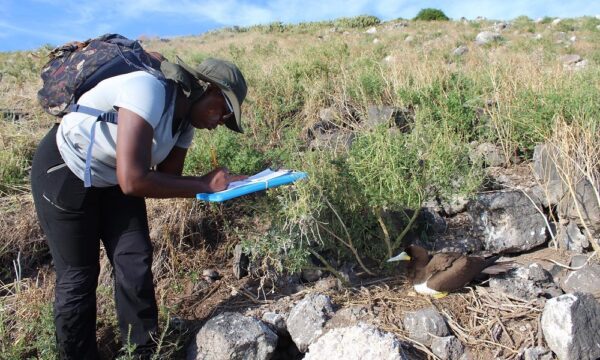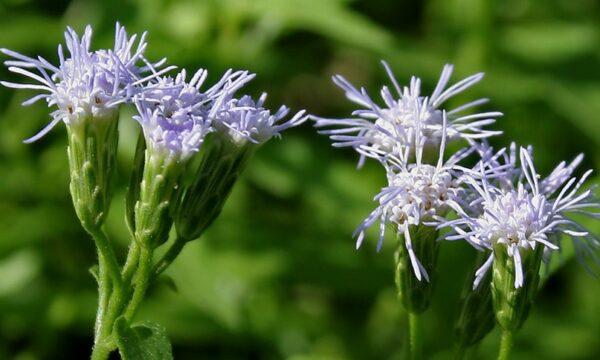
CABI has joined an international team of researchers to share their expertise as part of a new paper focused on guidelines and a framework to assess the feasibility of starting pre-emptive benefit-risk assessment of classical biological control agents (BCAs).
Dr Marc Kenis, Dr Lukas Seehausen, and Dr Kiran Horrocks, all based at CABI’s centre in Switzerland, shared their knowledge and experience of implementing classical biological control programmes to the paper published in Biological Control.
The research has been highlighted as part of a special issue entitled ‘Pre-emptive classical biological control: a novel approach to increase preparedness for potential biosecurity threats.’ This special issue is co-edited by CABI’s Dr Tim Haye who is an expert in the biocontrol of the brown marmorated stink bug.
The proposed guidelines and decision framework provide biocontrol practitioners with a suitable tool to assess if biocontrol risk assessment against a high-risk pest could be initiated before the establishment of the pest.
The scientists say that non-native invasive species – such as the fall armyworm (Spodoptera frugiperda) – threaten global biodiversity and food security which results in substantial economic costs reported to be more than US $100 billion annually.
Previous CABI research conducted in 2021 and published in CABI Agriculture and Bioscience, for instance, found that the fall armyworm alone caused the highest annual yield losses in Africa at USD $9.4 billion each year.
In the latest study, the scientists stress that 480,000 non-native species have been introduced into different ecosystems worldwide, and the threat posed by invasive species is increasing due to the globalisation of trade, tourism, and climate change.
They argue that identifying future risks, and preparing to manage those risks, is becoming increasingly important to help mitigate the impact that invasive species have on native ecosystems once established in a new environment.
Dr Kenis said, “Implementing pre-emptive biocontrol risk assessment means that natural enemies can be selected, screened in containment or abroad and potentially pre-approved prior to a pest establishing in the country at risk, thus improving classical biological control effectiveness.
“However, such an approach may not always be feasible. This contribution defines the fundamental prerequisites, principles, and objectives of pre-emptive biocontrol risk assessment.
“A set of guidelines and a decision framework were developed, which can be used to assess the feasibility of conducting a pre-emptive benefit-risk assessment for candidate biological control agents against high-risk arthropod pests.”
The researchers highlight New Zealand’s example of the pre-emptive biocontrol risk assessment conducted against the brown marmorated stink bug. This led to the pre-approval to release the samurai wasp (Trissolcus japonicus), in the event of the pest arriving in the country and is considered a world first as well as a significant outcome for pre-emptive biocontrol.
However, they suggest that such a pre-emptive approach is unlikely to be feasible for all insect pests.
Dr Seehausen said, “CBC is a crucial strategy for managing invasive insect pest populations. However, the deliberate introduction of an exotic BCA depends upon an often-lengthy research programme and biosafety benefit-risk assessment and is subject to regulatory approval.
“This gives additional time for an invasive pest to spread and cause damage. Therefore, a pre-emptive biocontrol benefit-risk assessment approach would help to enhance preparedness for a potential invasion of high-risk pest species.”
CABI’s contribution to the paper is part of an EUPHRESCO project on ‘Preparedness in biological control of priority biosecurity threats” and the project ‘Pre-emptive risk-benefit assessment for biocontrol agents of high-risk pests in Switzerland’ funded by the Swiss Federal Office for Agriculture and conducted in collaboration with Agroscope.
In total, scientists from 21 different institutions – including The New Zealand Institute for Plant & Food Research Limited and the CSIRO European Laboratory in France – contributed to the research. The full list of contributors can be seen in the paper.
Additional information
Main image: The Samurai wasp sets to work parasitizing the eggs of the brown marmorated stink bug (Credit: Tim Haye).
Full paper reference
Gonzalo A. Avila, M. Lukas Seehausen, Vincent Lesieur, Asha Chhagan, Valerie Caron, Rachel E. Down, Neil Audsley, Jana Collatz, Tibor Bukovinszki, Giuseppino Sabbatini Peverieri, Rob Tanner, Ramona Maggini, Panagiotis Milonas, Connor F. McGee, Kiran Horrocks, Annette Herz, Kathleen Lemanski, Gianfranco Anfora, Luka Batistič, Tanja Bohinc, Nicolas Borowiec, Mihaela Dinu, Ana-Cristina Fatu, Chiara Ferracini, Maria-Vassiliki Giakoumaki, Claudio Ioriatti, Mark Kenis, Žiga Laznik, Chris Malumphy, Marco V. Rossi Stacconi, Pio Federico Roversi, Stanislav Trdan, Barbara I.P. Barratt, ‘Guidelines and framework to assess the feasibility of starting pre-emptive risk assessment of classical biological control agents,’ Biological Control, Volume 187, 2023, DOI: https://doi.org/10.1016/j.biocontrol.2023.105387
The paper can be read open access here: https://www.sciencedirect.com/science/article/pii/S1049964423002402
Related News & Blogs
Biodiversity loss: How can we reclaim our landscapes from threats to biodiversity?
On 22nd May, we mark the International Day for Biological Diversity. In this article, CABI’s Global Director for Invasive Species Dr Hariet Hinz looks at how we can reclaim our landscapes from threats to biodiversity. Biodiversity loss is proceeding at…
22 May 2025




